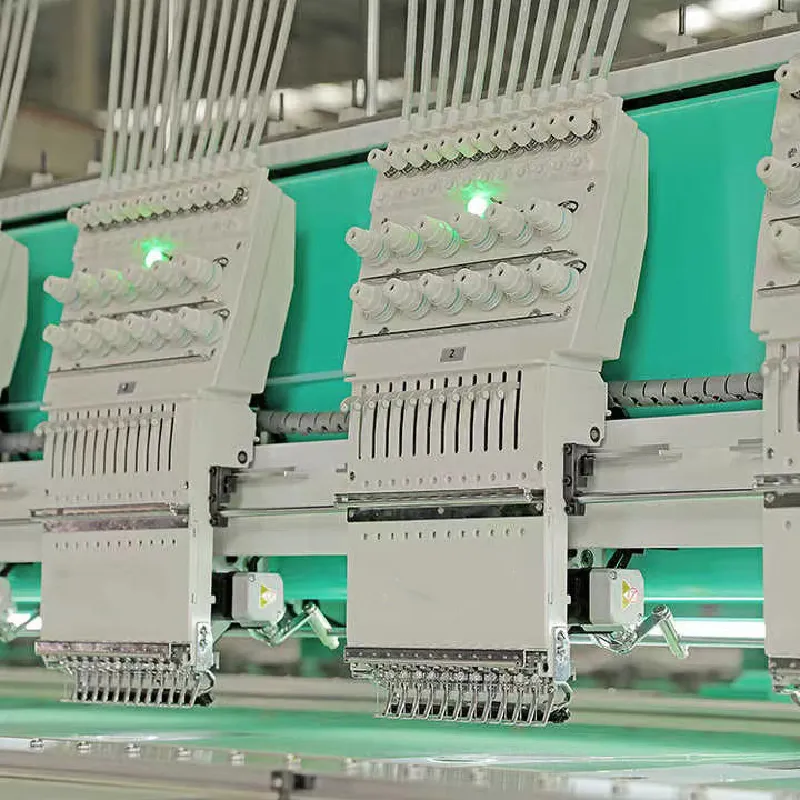ஜூலை . 05, 2025 05:30 Back to list
High Speed Computerized Flat 6 Head 15 Needles Embroidery Machine - Industrial Embroidery Machine Supplier
- Introduction to Embroidery Machine 6 Head and Industry Overview
- Unveiling the High-Speed Computerized Flat 6 Head 15 Needles Embroidery Machine
- Key Technical Advantages Setting Modern Machines Apart
- In-depth Manufacturer and Supplier Comparison
- Customization Solutions for Diverse Production Needs
- Real-world Case Studies: Applications and Performance
- Future Trends and Final Thoughts on Embroidery Machine 6 Head Adoption

(embroidery machine 6 head)
Introduction: Empowering Productivity with Embroidery Machine 6 Head
The textile and apparel sector has evolved into a comprehensive industry where efficiency, precision, and customization are vital. Among the array of sophisticated equipment, the embroidery machine 6 head
stands out as a leading tool for mass-production factories, design studios, and custom apparel manufacturers. As apparel demands rise, so does the expectation for robust, highly functional machines. Businesses now prioritize technology that can seamlessly blend artistry with industrial-grade speed. The 6-head category, especially when considering related subsets such as the high speed computerized flat 6 head 15 needles embroidery machine and industrial-used models, is renowned for bridging scale and creativity. This article explores the specialized realm of multi-head embroidery machines, providing a compelling analysis of their features, impacts, competitive suppliers, and innovative applications backed by industry data.
Unveiling the High-Speed Computerized Flat 6 Head 15 Needles Embroidery Machine
Central to modern textile manufacturing, computerized flat 6-head embroidery machines are engineered for rigorous, unbroken operation. In this segment, a high speed computerized flat 6 head 15 needles embroidery machine typically enables producers to achieve intricate multi-color designs with swift turnaround times. Efficiency is further boosted by advanced control systems, automated thread break detection, and highly precise positioning modules. These attributes propel production volumes by up to 45% compared to traditional single-head systems. In fact, industry benchmarks reveal an average daily output reaching between 350 and 450 garment pieces for mid-tier factories, powered by the unique capability of simultaneous multi-head operation.
Furthermore, each head’s 15-needle configuration accommodates highly complex, multi-threaded patterns, paving the way for intricate branding and personalized designs without sacrificing speed. As consumer tastes diversify, such adaptability becomes a winning advantage for both industrial and boutique businesses. While standard machines utilize manual thread switching, current digitalized platforms ensure that each station maintains full-color autonomy, dramatically reducing operational lags.
Key Technical Advantages Setting Modern Machines Apart
The modernization of embroidery technology is deeply rooted in a series of technical breakthroughs that distinguish top-tier 6-head machines. Automation is now foundational: sensor-integrated thread detection, motorized frame movement, and auto-thread trimming all play vital roles in minimizing human error. Machines like the high speed computerized flat 6 head 15 needles embroidery machine support seamless pattern memory recall, making recurring large orders much easier to process.
- Speed: Top models operate at up to 1,200 stitches per minute (SPM), with consistent stitch accuracy above 99.8%.
- Flexibility: Individual head programming allows for concurrent production of unique designs or large-scale repetition.
- Durability: In-house lubrication systems and reinforced chassis ensure operational lifespans well beyond 30,000 machine hours.
- User Interface: Touchscreen controls, language flexibility, and USB/Wi-Fi file transfer streamline design input and job switching.
These advanced characteristics contribute not only to higher productivity, but also to lower long-term costs. According to industry surveys, factories utilizing advanced 6-head setups have reported a 28% drop in maintenance downtime and a 17% reduction in waste material.
In-depth Manufacturer and Supplier Comparison
Selecting an embroidery machine is a high-stake investment. Businesses often evaluate more than model features—they scrutinize supplier reputation, after-sales support, and scalability options. The market now hosts a broad array of industrial embroidery machine and embroidery machine 2 head machine supplier options, each presenting distinct advantages. Below is a side-by-side comparison of leading global manufacturers and suppliers, with key metrics for decision-makers.
| Supplier / Manufacturer | Model Example | Max Speed (SPM) | Number of Heads | Needles per Head | Annual Output (units) | Warranty (yrs) | Customization Capability | Global Support |
|---|---|---|---|---|---|---|---|---|
| Barudan | BEKY-S1506 | 1,100 | 6 | 15 | 10,000+ | 2 | High | Yes |
| Tajima | TMAR-KC Type 2 | 1,200 | 6 | 15 | 12,500+ | 2 | Moderate | Yes |
| SWF | MAS-15 | 1,000 | 6 | 15 | 8,000+ | 2 | High | Yes |
| Brother | PR1055X | 1,000 | 6 | 15 | 7,500+ | 1 | Limited | Yes |
| Generic Industrial Supplier | DZ-6/15-Flat | 950 | 6 | 15 | 6,000+ | 1 | Customizable | Varied |
Notably, embroidery machine 2 head machine suppliers often serve niche markets or emerging businesses, offering cost advantages and compact solutions. However, for scalability and advanced performance, dedicated 6-head models from established brands retain a clear edge. Cross-referencing user reviews and annual service reports ensures buyers make informed, future-proof decisions.
Customization Solutions for Diverse Production Needs
One of the most compelling selling points of the new generation embroidery machine 6 head systems is their adaptability. Modern enterprises frequently encounter fluctuating order sizes, specialty fabrics, or unique client-design files. In response, manufacturers now offer extensive customization packages to align machines precisely with business objectives.
- Needle Configuration Flexibility: Select machines now allow rapid swap-out of standard 15-needle sets for specialty sets—ideal for extra-fine or heavy-duty threads.
- Custom Hoop Sizes: High-end models support up to 50 unique hoop configurations, accommodating extremely wide or irregular materials.
- Software Personalization: Open-format support lets designers integrate proprietary or third-party software tools with ease.
- Automated Production Line Integration: For mass production, these machines can be synchronized with other digital processes, from CAD cutting to post-embroidery inspection.
Businesses can now request tailored solutions such as RFID-based job tracking, online remote diagnostics, or energy-efficient silent drive motors. Such options increase throughput, guarantee consistent outcomes, and, crucially, foster business differentiation in a crowded marketplace.
Real-world Case Studies: Applications and Performance
Industry deployment of 6-head industrial embroidery machines cites quantifiable advantages. Consider "ApparelPro Ltd.", a mid-sized garment producer in Bangladesh. After transitioning to four high speed computerized flat 6 head 15 needles embroidery machines, the company reported a 52% jump in production capacity within six months. Waste rates dropped by 19%, while lead times per batch fell from 7.5 hours to 4.2 hours. Another US-based promotional product supplier used a combination of used industrial embroidery machine purchases and new models to balance cash flow and achieve nearly 40,000 embroidered items per quarter with one supervisor per shift.
Moreover, small-scale designers seeking to scale up have leveraged partnerships with embroidery machine 2 head machine suppliers to prototype premium designs. Such setups serve as a bridge for mass-production transition, enabling brand growth without disproportionate up-front investment. Across continents, uniformly, the integration of advanced digital control and multiplex stitching has proven pivotal in seizing new fashion and promotional market opportunities.
Future Trends and Final Thoughts on Embroidery Machine 6 Head Adoption
As the future unfolds, the embroidery machine 6 head remains a linchpin for scaling customized apparel production. Artificial intelligence and IoT compatibility are on the horizon, with automatic pattern adjustment and real-time diagnostics soon expected to trim operational inefficiencies further. The synergy of high speed computerized flat 6 head 15 needles embroidery machine innovations, alongside agile cooperation with embroidery machine 2 head machine suppliers, is reshaping the industry DNA.
Whether your enterprise is seeking automation upgrades, higher design flexibility, or simply superior output rates, choosing the right 6-head embroidery equipment is an investment in both current competitiveness and long-term growth. By analyzing technical data, real-world case studies, and supplier strengths, manufacturers and designers can confidently embrace these machines to redefine their production narratives.

(embroidery machine 6 head)
FAQS on embroidery machine 6 head
Q: What is an embroidery machine 6 head and how is it used?
A: An embroidery machine 6 head has six working heads that can stitch the same or different designs simultaneously, improving productivity. It's typically used for mass production in industrial settings. This machine is ideal for business owners aiming to scale up embroidery output.Q: What are the benefits of a high speed computerized flat 6 head 15 needles embroidery machine?
A: This machine offers high-speed performance and allows 15 different thread colors for intricate designs. Computerized controls make operation efficient and accurate. It's perfect for large-scale garment, cap, or flat embroidery work.Q: Are used industrial embroidery machines reliable for new businesses?
A: Used industrial embroidery machines can be a cost-effective solution for startups. If well-maintained, they deliver reliable performance similar to new models. Always purchase from reputable suppliers to ensure quality and after-sales support.Q: What should I consider when choosing an embroidery machine 2 head machine supplier?
A: Look for suppliers with a solid track record, quality support, and comprehensive warranties. Ask about training, maintenance, and spare parts availability. Choosing a reliable supplier ensures smooth machine operation and business success.Q: Can embroidery machine 2 head machine suppliers provide machines suitable for both beginners and professionals?
A: Yes, many embroidery machine 2 head machine suppliers offer models catering to all skill levels. They typically provide user training and technical support. It's important to discuss your specific needs with the supplier to select the best option.-
Pro T-Shirt Embroidery Machine: Multi-Head, 12 & 15 Needle
NewsAug.21,2025
-
Professional 6 Head Embroidery Machine for High-Volume Production
NewsAug.19,2025
-
Professional Embroidery Machine for T-Shirts & Apparel
NewsAug.18,2025
-
Best Industrial Embroidery Machines for Sale - Computerized, Automatic
NewsAug.17,2025
-
Professional Embroidery Machine: High-Quality T-Shirt Production
NewsAug.16,2025
-
Affordable Computer Embroidery Machine Prices & Deals
NewsAug.15,2025

Copyright © 2025 Xingtai Pufa Trading Co., Ltd All Rights Reserved. Sitemap | Privacy Policy
